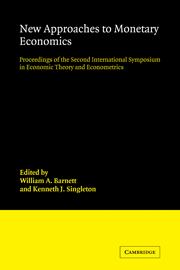 New Approaches to Monetary Economics
New Approaches to Monetary Economics Published online by Cambridge University Press: 04 August 2010
Introduction
Surveys of the participants in organized securities markets indicate that traders hold widely different beliefs about the future course of economic activity. Expectations not only differ, but they evidently respond significantly to unexpected movements in such variables as real economic growth and the weekly changes in the money stock [see Cornell (1983) for a review of some of this literature]. Furthermore, French and Roll (1984) have found that the variance of stock prices is greater over periods when the stock market is open than when it is closed. Together, these observations suggest that disparate beliefs and the sharing of information through the trading process may be important ingredients in modeling asset-price determination. The purpose of this paper is to explore the implications of disparate expectations for the time-series properties of asset prices in the context of a simple model with competitive traders facing serially correlated shocks.
While the models examined are partial equilibrium in nature, this exploration is motivated in part by the apparent inconsistency of representative agent, dynamic equilibrium models with the behavior of asset prices. The variances and autocorrelation functions of asset returns seem to be inconsistent with the implications of both linear expectations models [see, e.g., Shiller (1979, 1981), Singleton (1980, 1985), Scott (1985)] and the nonlinear models studied by Hansen and Singleton (1982), Ferson (1983), Dunn and Singleton (1985), and Eichenbaum and Hansen (1985), among others.
To save this book to your Kindle, first ensure [email protected] is added to your Approved Personal Document E-mail List under your Personal Document Settings on the Manage Your Content and Devices page of your Amazon account. Then enter the ‘name’ part of your Kindle email address below. Find out more about saving to your Kindle.
Note you can select to save to either the @free.kindle.com or @kindle.com variations. ‘@free.kindle.com’ emails are free but can only be saved to your device when it is connected to wi-fi. ‘@kindle.com’ emails can be delivered even when you are not connected to wi-fi, but note that service fees apply.
Find out more about the Kindle Personal Document Service.
To save content items to your account, please confirm that you agree to abide by our usage policies. If this is the first time you use this feature, you will be asked to authorise Cambridge Core to connect with your account. Find out more about saving content to Dropbox.
To save content items to your account, please confirm that you agree to abide by our usage policies. If this is the first time you use this feature, you will be asked to authorise Cambridge Core to connect with your account. Find out more about saving content to Google Drive.